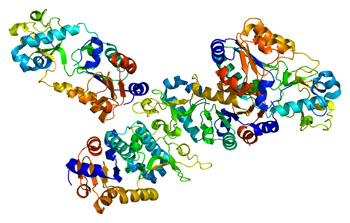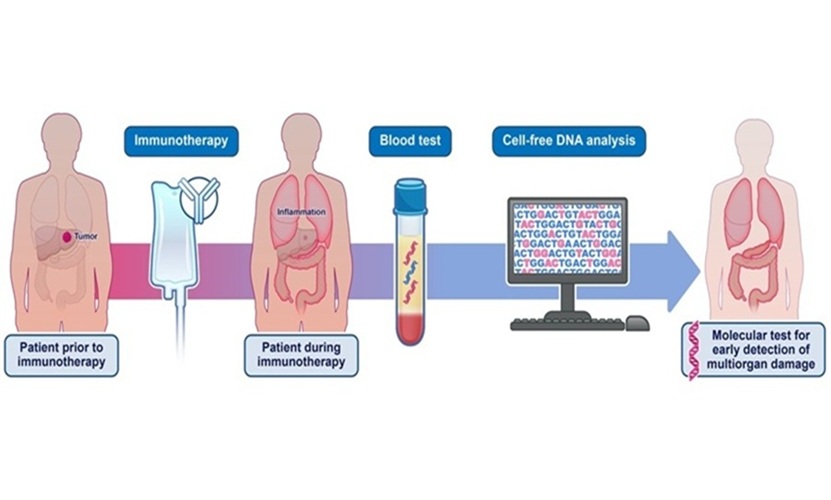Cardiomyopathy Linked to Faulty Regulation of Heart Protein Succinylation
|
By LabMedica International staff writers Posted on 28 Apr 2016 |

Image: A model of the structure of the SIRT5 protein (Photo courtesy of Wikimedia Commons).
The enzyme SIRT5, also known as sirtuin (silent mating type information regulation 2 homolog) 5, was found to play a critical role in maintaining healthy cardiac function by regulating the lysine succinylation modification of heart cell proteins.
Lysine succinylation is a recently discovered protein posttranslational modification (PTM), and SIRT5 is an efficient desuccinylase enzyme. Although many mammalian proteins have been found to be regulated by lysine succinylation and SIRT5, the physiological significance of succinylation and SIRT5 remains unknown.
To better understand the consequences of protein succinylation, investigators at Cornell University (Ithaca, NY, USA) and their colleagues at Ecole Polytechnique Fédérale de Lausanne (Switzerland) profiled acyl-CoA molecules in various mouse tissues. They discovered that different tissues had different acyl-CoA profiles and that succinyl-CoA was the most abundant acyl-CoA molecule in the heart. This observation prompted them to examine protein lysine succinylation in different mouse tissues in the presence and absence of SIRT5.
The investigators reported in the April 5, 2016, online edition of the journal Proceedings of the [U.S.] National Academy of Sciences that protein lysine succinylation predominantly accumulated in the heart in mice that had been genetically engineered to lack the gene for Sirt5. Using proteomic studies, they were able to identify many cardiac proteins regulated by SIRT5.
In particular, they found that ECHA (also known as HADHA or hydroxyacyl-CoA dehydrogenase/3-ketoacyl-CoA thiolase/enoyl-CoA hydratase (trifunctional protein), alpha subunit), a protein involved in fatty acid oxidation, was a major enzyme that was regulated by SIRT5 and affected heart function. Sirt5 knockout (KO) mice had lower ECHA activity, increased long-chain acyl-CoAs, and decreased ATP in the heart under fasting conditions. On the physiological level, it was found that Sirt5 KO mice developed hypertrophic cardiomyopathy, as evident from the increased heart weight relative to body weight in these animals.
"Our research suggests that perhaps one way to improve heart function is to find a way to improve SIRT5 activity," said senior author Dr. Hening Lin, professor of chemistry and chemical biology at Cornell University.
"The identification of this new role of SIRT5 in cardiomyopathy assigns an important role of this druggable enzyme in one of the major cardiac diseases," said contributing author Dr. Johan Auwerx, professor of energy metabolism at the Ecole Polytechnique Fédérale de Lausanne. "It can be expected that pharmacological interference with these pathways will lead to new therapies for cardiomyopathy that, as such, can extend healthy life span."
Related Links:
Cornell University
Ecole Polytechnique Fédérale de Lausanne
Lysine succinylation is a recently discovered protein posttranslational modification (PTM), and SIRT5 is an efficient desuccinylase enzyme. Although many mammalian proteins have been found to be regulated by lysine succinylation and SIRT5, the physiological significance of succinylation and SIRT5 remains unknown.
To better understand the consequences of protein succinylation, investigators at Cornell University (Ithaca, NY, USA) and their colleagues at Ecole Polytechnique Fédérale de Lausanne (Switzerland) profiled acyl-CoA molecules in various mouse tissues. They discovered that different tissues had different acyl-CoA profiles and that succinyl-CoA was the most abundant acyl-CoA molecule in the heart. This observation prompted them to examine protein lysine succinylation in different mouse tissues in the presence and absence of SIRT5.
The investigators reported in the April 5, 2016, online edition of the journal Proceedings of the [U.S.] National Academy of Sciences that protein lysine succinylation predominantly accumulated in the heart in mice that had been genetically engineered to lack the gene for Sirt5. Using proteomic studies, they were able to identify many cardiac proteins regulated by SIRT5.
In particular, they found that ECHA (also known as HADHA or hydroxyacyl-CoA dehydrogenase/3-ketoacyl-CoA thiolase/enoyl-CoA hydratase (trifunctional protein), alpha subunit), a protein involved in fatty acid oxidation, was a major enzyme that was regulated by SIRT5 and affected heart function. Sirt5 knockout (KO) mice had lower ECHA activity, increased long-chain acyl-CoAs, and decreased ATP in the heart under fasting conditions. On the physiological level, it was found that Sirt5 KO mice developed hypertrophic cardiomyopathy, as evident from the increased heart weight relative to body weight in these animals.
"Our research suggests that perhaps one way to improve heart function is to find a way to improve SIRT5 activity," said senior author Dr. Hening Lin, professor of chemistry and chemical biology at Cornell University.
"The identification of this new role of SIRT5 in cardiomyopathy assigns an important role of this druggable enzyme in one of the major cardiac diseases," said contributing author Dr. Johan Auwerx, professor of energy metabolism at the Ecole Polytechnique Fédérale de Lausanne. "It can be expected that pharmacological interference with these pathways will lead to new therapies for cardiomyopathy that, as such, can extend healthy life span."
Related Links:
Cornell University
Ecole Polytechnique Fédérale de Lausanne
Latest BioResearch News
- Genome Analysis Predicts Likelihood of Neurodisability in Oxygen-Deprived Newborns
- Gene Panel Predicts Disease Progession for Patients with B-cell Lymphoma
- New Method Simplifies Preparation of Tumor Genomic DNA Libraries
- New Tool Developed for Diagnosis of Chronic HBV Infection
- Panel of Genetic Loci Accurately Predicts Risk of Developing Gout
- Disrupted TGFB Signaling Linked to Increased Cancer-Related Bacteria
- Gene Fusion Protein Proposed as Prostate Cancer Biomarker
- NIV Test to Diagnose and Monitor Vascular Complications in Diabetes
- Semen Exosome MicroRNA Proves Biomarker for Prostate Cancer
- Genetic Loci Link Plasma Lipid Levels to CVD Risk
- Newly Identified Gene Network Aids in Early Diagnosis of Autism Spectrum Disorder
- Link Confirmed between Living in Poverty and Developing Diseases
- Genomic Study Identifies Kidney Disease Loci in Type I Diabetes Patients
- Liquid Biopsy More Effective for Analyzing Tumor Drug Resistance Mutations
- New Liquid Biopsy Assay Reveals Host-Pathogen Interactions
- Method Developed for Enriching Trophoblast Population in Samples
Channels
Clinical Chemistry
view channel
Online Tool Detects Drug Exposure Directly from Patient Samples
Doctors often rely on patient interviews and medical records to determine what medications a person has taken, but this information is frequently incomplete. People may forget drugs they used, take over-the-counter... Read more
Chemical Imaging Probe Could Track and Treat Prostate Cancer
Prostate cancer remains a leading cause of illness and death among men, with many patients eventually developing resistance to standard hormone-blocking therapies. These drugs often lose effectiveness... Read moreMolecular Diagnostics
view channel
CLIA Test Identifies Head and Neck Cancer Recurrence from Post-Surgical Lymphatic Fluid
While the lymphatic system’s critical role in metastasis has long been recognized, routine access to patient lymph has been elusive. Now, a non-invasive process can access lymph through the collection... Read more
New 15-Minute Hepatitis C Test Paves Way for Same-Day Treatment
Chronic hepatitis C infection affects an estimated 50 million people worldwide and causes around 242,000 deaths each year, largely due to cirrhosis and liver cancer. Although the infection is curable with... Read moreHematology
view channel
MRD Tests Could Predict Survival in Leukemia Patients
Acute myeloid leukemia is an aggressive blood cancer that disrupts normal blood cell production and often relapses even after intensive treatment. Clinicians currently lack early, reliable markers to predict... Read more
Platelet Activity Blood Test in Middle Age Could Identify Early Alzheimer’s Risk
Early detection of Alzheimer’s disease remains one of the biggest unmet needs in neurology, particularly because the biological changes underlying the disorder begin decades before memory symptoms appear.... Read more
Microvesicles Measurement Could Detect Vascular Injury in Sickle Cell Disease Patients
Assessing disease severity in sickle cell disease (SCD) remains challenging, especially when trying to predict hemolysis, vascular injury, and risk of complications such as vaso-occlusive crises.... Read more
ADLM’s New Coagulation Testing Guidance to Improve Care for Patients on Blood Thinners
Direct oral anticoagulants (DOACs) are one of the most common types of blood thinners. Patients take them to prevent a host of complications that could arise from blood clotting, including stroke, deep... Read moreImmunology
view channel
Blood Test Could Detect Adverse Immunotherapy Effects
Immune checkpoint inhibitors have transformed cancer treatment, but they can also trigger serious immune-related adverse events that damage healthy organs and may become life-threatening if not detected early.... Read more
Routine Blood Test Can Predict Who Benefits Most from CAR T-Cell Therapy
CAR T-cell therapy has transformed treatment for patients with relapsed or treatment-resistant non-Hodgkin lymphoma, but many patients eventually relapse despite an initial response. Clinicians currently... Read moreMicrobiology
view channel
Blood-Based Diagnostic Method Could Identify Pediatric LRTIs
Lower-respiratory tract infections (LRTIs) are a leading cause of illness and death worldwide, and pneumonia is the leading infectious cause of death in children under five, claiming the lives of over... Read more
Rapid Diagnostic Test Matches Gold Standard for Sepsis Detection
Sepsis kills 11 million people worldwide every year and generates massive healthcare costs. In the USA and Europe alone, sepsis accounts for USD 100 billion in annual hospitalization expenses.... Read moreRapid POC Tuberculosis Test Provides Results Within 15 Minutes
Tuberculosis remains one of the world’s deadliest infectious diseases, and reducing new cases depends on identifying individuals with latent infection before it progresses. Current diagnostic tools often... Read more
Rapid Assay Identifies Bloodstream Infection Pathogens Directly from Patient Samples
Bloodstream infections in sepsis progress quickly and demand rapid, precise diagnosis. Current blood-culture methods often take one to five days to identify the pathogen, leaving clinicians to treat blindly... Read morePathology
view channel
Rapid Low-Cost Tests Can Prevent Child Deaths from Contaminated Medicinal Syrups
Medicinal syrups contaminated with toxic chemicals have caused the deaths of hundreds of children worldwide, exposing a critical gap in how these products are tested before reaching patients.... Read more
Tumor Signals in Saliva and Blood Enable Non-Invasive Monitoring of Head and Neck Cancer
Head and neck cancers are among the most aggressive malignancies worldwide, with nearly 900,000 new cases diagnosed each year. Monitoring these cancers for recurrence or relapse typically relies on tissue... Read more
Common Health Issues Can Influence New Blood Tests for Alzheimer’s Disease
Blood-based tests for Alzheimer’s disease are transforming diagnosis by offering a simpler alternative to spinal taps and brain imaging. However, many people evaluated at memory clinics also live with... Read more
Blood Test Formula Identifies Chronic Liver Disease Patients with Higher Cancer Risk
Chronic liver disease affects millions worldwide and can progress silently to hepatocellular carcinoma (HCC), one of the deadliest cancers globally. While surveillance guidelines exist for patients with... Read moreTechnology
view channel
Machine Learning Models Diagnose ALS Earlier Through Blood Biomarkers
Amyotrophic lateral sclerosis (ALS) is a rapidly progressive neurodegenerative disease that is notoriously difficult to diagnose in its early stages. Early symptoms often overlap with other neurological... Read more
Artificial Intelligence Model Could Accelerate Rare Disease Diagnosis
Identifying which genetic variants actually cause disease remains one of the biggest challenges in genomic medicine. Each person carries tens of thousands of DNA changes, yet only a few meaningfully alter... Read moreIndustry
view channel
BD and Penn Institute Collaborate to Advance Immunotherapy through Flow Cytometry
BD (Becton, Dickinson and Company, Franklin Lakes, NJ, USA) has entered into a strategic collaboration with the Institute for Immunology and Immune Health (I3H, Philadelphia, PA, USA) at the University... Read more





















